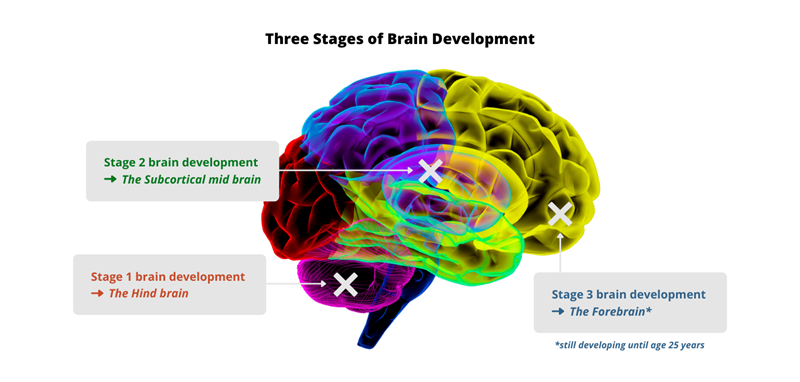Introduction
It used to be believed that the brain finished developing during childhood. However, new discoveries in neuroscience have revealed the brain continues to develop and mature well into early adulthood and doesn’t finish until 25 years of age. This means during childhood, adolescence, and early adulthood, the brain is undergoing major structural integration, which changes the way the brain functions.
Brain development during this period is dynamic and involves the creation of new neural networks, which connect and strengthen different brain regions. Generally speaking, brains mature from back to front with the most basic functions developing first in the hindbrain, followed by primitive instincts in the subcortical midbrain, with the most complex functions maturing last in the forebrain.
THE ‘HINDBRAIN’, which matures early on in life, is responsible for basic automatic functions like breathing, heart rate, and coordination.
THE ‘SUBCORTICAL MIDBRAIN’, which matures during adolescence, is responsible for primitive instincts, like the fight or flight response, memory storage, and pleasure. The subcortical midbrain also helps to regulate bodily functions, such as temperature and metabolism.
THE ‘FOREBRAIN’, which matures during early adulthood, is responsible for complex, high-level thinking, including judgement, planning for the future, and managing emotions.

Effects of drugs on the brainContinued brain development during adolescence and early adulthood can make the brain more vulnerable to the negative impacts of alcohol and other drug use. The harms caused by a specific drug can depend on the brain region it affects as well as the dose/amount of the drug taken. Examples of the harms of different drugs are described below.
Some drugs have broad ranging effects on the brain, and the regions impacted depend on the dose taken.
- For example, low doses of alcohol can affect the forebrain and impact cognition, making people become more relaxed and disinhibited. Moderate doses of alcohol can affect the subcortical midbrain and impact memory function, and cause ‘black outs’. High doses of alcohol can affect the hindbrain and impact breathing and heart rate and can lead to fatal overdose.
Some drugs have specific and localised effects on the brain.
- For example, MDMA/ecstasy can affect the subcortical midbrain and impact the brain’s temperature control mechanism, leading to increased body temperature and overheating.
Some drugs may affect the neural systems that underlie brain development.
- For example, the active ingredient in cannabis (THC) can affect the brain’s cannabinoid system, which plays a role in coordinating the structural development of the brain. Frequent cannabis use during this time may have ongoing and negative effects on brain development.
As more is learnt about the developing brain, we can better understand the short and long-term effects of drugs such as alcohol, MDMA, and cannabis. Further research will help us to answer more complex questions around the brain’s ability to recover after drug use, and whether some people are at elevated risk of drug-related harms compared to others.
Until then, it is recommended that young people avoid, delay, and reduce their use of alcohol and other drugs, to promote healthy and complete brain development into adulthood.
Evidence Base
This factsheet was developed following expert review by researchers at the Matilda Centre for Research in Mental Health and Substance Use at the University of Sydney.